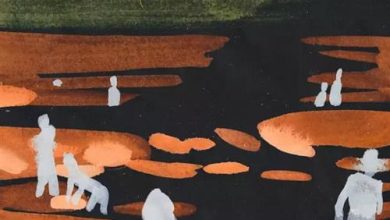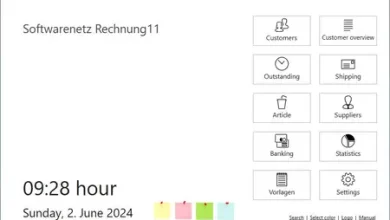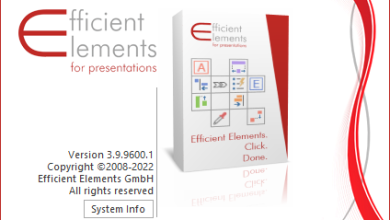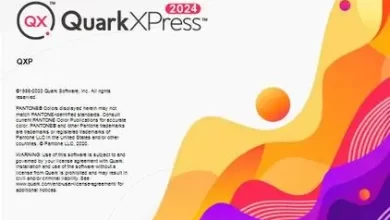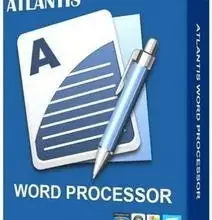Autodesk VRED Pro & Design 2025.2.0 with Assets Win x64
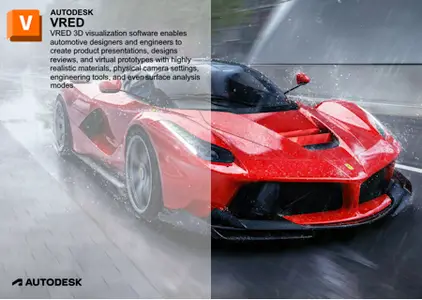
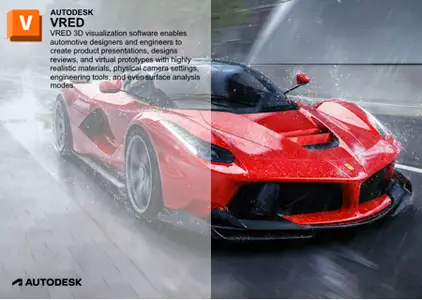
Free Download Autodesk VRED Pro & Design 2025.2.0 with Assets | 17.2 Gb
Autodesk Inc. has releasedVRED Products 2025.2.0is an visualization software enables automotive designers and engineers to create product presentations, design reviews, and virtual prototypes with highly realistic materials, physical camera settings, engineering tools, and even surface analysis modes
Owner:Autodesk Inc.
Product Name:VRED
Version:VRED Pro & Design 2025.2.0 with Assets
Supported Architectures:x64
Website Home Page :www.autodesk.com
Languages Supported:english
System Requirements:Windows *
Size:17.2 Gb.
What’s new in VRED 2025.2.0
Features
– OpenXR: Implemented the HTC passthrough extension
– Rendering: Added Wide Gamut rendering color spaces
– Rendering: Added a preference, Inline Textures, for storing Substance textures in a VPB/OSB file
– Rendering: Added support for a Substance PBR Coated (Metallic/Roughness) workflow
– Scripting: MIME data access for drag´n drop to script plugin GUI
Improvements
– Annotation Module: Added grouping functionality, depth search, and a tree expand/collapse slider
– Camera Editor: Added Automatic ISO Adaption to automatically adjusts the camera sensor’s ISO when the F-Stop or shutter speed changes to maintain consistent brightness
– Camera Editor: Exposed AgX controls for power and saturation
– Camera Editor: Glow and Glare controls are no longer limited to 2 digits
– Custom Plugin Interface: Added more functionality
– FileIO: Added an import option to filter invisible instances for all file formats
– FileIO: Alias animations can now be imported to VRED from WIRE
– FileIO: Importing a 3MF file with a texture loads the attached texture as expected
– GPU Raytracing: Added preference option to prefer optimization for memory consumption
– General: Improved texture compression for VPBs by adding the vrMaterialService.compressTextures Python command
– General: Replaced the GL Info with a GPU Information dialog
– General: Updated MDL SDK to 2024.0.1
– General: We are using CUDA events for synchronization to improve performance, especially when there is movement in the scene requiring updates
– Linux: VRED now allows the usage of Infiniband on new distributions
– OpenXR: Improved how a lost gaze is handled when using foveated rendering with a Varjo headset
– Preferences: Changing the import temporary path of a file no longer requires a VRED restart
– Rendering: Added read and write support of the color space information for EXR and floating point TIFF/PSD files
– Rendering: Optimized memory consumption for Substance textures which contain a uniform color
– Scenegraph: Added the Find function (Ctrl + F) for selected Scenegraph hierarchy
– Scripting: Implemented save and load for PhysX actors
– Streaming: Updated OpenH264 codec version
– UI: Adjusted styling of the License and About dialogs
– UI: Float values now have a precision of 6 digits
– VR: VR devices and hands are now rendered in Raytracing modes with color corrections, such as tonemapping and gamma, applied
– XR: Renamed the Extended Reality > HMD preference to XR Options
Bugfixes
– Animation: Animations on copied materials can now be unshared and changed independently
– Camera Editor: The Depth of Field in the Camera Editor > Camera Settings tab > Lens Attributes section, is now calculated correctly
– CPU Raytracing: Fixed slightly too sharp reflections on rough clearcoat (roughness > 0)
– CPU Raytracing: Substance materials no longer show blank Occlusion rendering
– CPU Raytracing: There is no longer an issue with disk lights in Approximated mode that have a very small roughness value
– CPU-Raytracing: A VDB emission is no longer fully transparent when using multi-scattering
– Camera Editor: Paste tonemapping attributes now also works for Sensor Response attributes when using a physical camera tonemapper
– FileIO: A Catia V5 file using the lightweight importer no longer has geometric issues
– FileIO: Alias .wire files with Enable Stitching unchecked can now be imported into VRED
– FileIO: Alias .wire files with Import Lights enabled can now be imported into VRED
– GPU Raytracing: Glass Material with Density and Exterior Color set to white no longer produces errors
– GPU Raytracing: Renderpasses are now updated from the Render Queue, no longer causing Cuda errors
– General: In the Color Picker dialog, after inputting a red value (1, 0, 0), clicking Apply, then closing and reopening the dialog, the value remains unchanged (1, 0, 0)
– General: Local clipping planes are now evaluated correctly for mouse interactions in the viewport
– General: Switching to HDR10 Display no longer crashes when Depth of Field Autofocus is enabled
– General: The resolution of the A1 image size preset in the preferences is now correct
– General: Using Convert > Mesh on a specific mesh no longer causes a crash
– General: When a camera is animated, the ICV is triggered, and FoV is changed, the FStop remains constant
– VR: In VR, the XRay material on hands looks correct when in Raytracing mode
– Material Editor: Fixed the environment “Boost Light” function to no longer cause infinite values in the changed image, leading to a “black sun” and overall lighting that is too dark in GPU Raytracing
– Material Editor: Multi-selecting materials with dispersion no longer crashes
– Material Editor: The VRED interface now respects the Substance parameter grouping order of imported .sbsar files
– Metadata Editor: Metadata appears for .osb files imported with Import as Smart Reference enabled
– Metadata Editor: There are no longer issues with setting string lists as metadata through the Python interface
– OpenGL: Fixed bump mapping for materials with planar texture mapping, ensuring surface normals are correctly oriented and reflections are accurate
– OpenGL: The SSAO Blur Amount input value is now clamped, preventing any freezing issues
– OpenGL: VRED no longer crashes when entering a large number of shadow lightsources in the Environment settings
– OpenGL: Volumes no longer disappear when switching to an HDR10 display
– OpenGL: When Double Sided is disabled for an object in the Render Layer, the scene is saved, and reloaded, the object remains single sided in OpenGL
– OpenGL: When using the Infinite Tiling in a Substance material, it is now applied to all textures
– OpenXR: The laser pointer issue when using the Place tool has been corrected when in OpenXR
– OpenXR: The Place tool now works in MR mode
– OpenXR: The stuttering issue for the StreamVR runtime when depth composition layer is enabled has been resolved in OpenXR
– OpenXR: Using the Python function, setMixedRealityEyeOffsetPercentage, will now change the scaling between video passthrough and rendering
– Preferences: If changes are made to the Import/Export > File Options > Scene section and applied, they are also automatically applied to the Import File(s) dialog
– Preferences: Python Sandbox allowed modules no longer accumulate each time the preferences are opened
– Raytracing: Use Automatic Photon Radius is now found in the VRED Python API V1 documentation
– Rendering: Tangents are now accurately computed for skinned meshes, resulting in correct illumination
– Rendering: The VDB volume bounding size is now respected correctly
– Scenegraph: Hiding objects in large scenes no longer causes lags of the Scenegraph
– Scenegraph: In the tag view, Show/Hide is now applied to objects and their clones
– Scenegraph: Tag view performance improved for large scenes with many nodes
– Scripting: Added vrMaterialEntryType to the Python API v2 documentation
– Scripting: Enum values in vrNodeService::traverse are working again
– Scripting: Fixed vrSessionService.blockSync(commandTypeName) so that it blocks only the specific command type instead of everything
– Scripting: No vrKernelServices error occurs after New Scene is initiated
– Scripting: The childrenFileConversionFinished signal for vrFileIOService is now always emitted
– Scripting: Using removeNURBS(getRootNode()) no longer crashes VRED
– UI: The UI now updates depending on the lock/unlock state of a sceneplate asset
– UI: Cluster-related progress strings are now localized
– UI: Convert to Smart Reference no longer overlaps the arrow in the Reference menu
– UI: Expand/collapse triangles in the Preferences keep their size when DPI scaling is used
– UI: Fixed capitalization issues within some menus
– UI: Fixed spelling issues in Render Settings > Raytracing Quality > Volume Quality > Mode
– UI: Fixed the Encrypted HTTPS Only status when the Enable Web Server option is disabled
– UI: Illumination Channels no longer overlaps the arrow in the Renderpasses Rendering menu
– UI: Removed superfluous items from the Re-Import dialog
– UI: Strings no longer overlap the arrow in the Renderpasses Rendering menu
– UI: When Enable Photometric Parameters is enabled, the Incandescence section colors values for a plastic material remain unchanged even after the dialog is closed, then reopened
– UV Editor: Lightmap illumination textures are now no longer shown as transparent in UV view
– UV Editor: Material textures (hdr formats) are no longer tonemapped when Preferences > Scene > Bake > Lightmaps > Tone Map Previews is enabled
– XR: The Python function, vrHMDService.setDepthTextureEnabled, works again as expected
– XR: The Varjo XR-3 depth buffer can now be disabled when using an OpenXR HMD
– XR: The orientation of the laser pointer will now match the the orientation of the hands
Features
– OpenXR: Implemented the HTC passthrough extension
– Rendering: Added Wide Gamut rendering color spaces
– Rendering: Added a preference, Inline Textures, for storing Substance textures in a VPB/OSB file
– Rendering: Added support for a Substance PBR Coated (Metallic/Roughness) workflow
Improvements
– Annotation Module: Added grouping functionality, depth search, and a tree expand/collapse slider
– Camera Editor: Added Automatic ISO Adaption to automatically adjusts the camera sensor’s ISO when the F-Stop or shutter speed changes to maintain consistent brightness
– Camera Editor: Exposed AgX controls for power and saturation
– Camera Editor: Glow and Glare controls are no longer limited to 2 digits
– FileIO: Added an import option to filter invisible instances for all file formats
– FileIO: Alias animations can now be imported to VRED from WIRE
– FileIO: Importing a 3MF file with a texture loads the attached texture as expected
– General: Improved texture compression for VPBs by adding the vrMaterialService.compressTextures Python command
– General: Replaced the GL Info with a GPU Information dialog
– General: Updated MDL SDK to 2024.0.1
– General: We are using CUDA events for synchronization to improve performance, especially when there is movement in the scene requiring updates
– Linux: VRED now allows the usage of Infiniband on new distributions
– OpenXR: Improved how a lost gaze is handled when using foveated rendering with a Varjo headset
– Preferences: Changing the import temporary path of a file no longer requires a VRED restart
– Rendering: Added read and write support of the color space information for EXR and floating point TIFF/PSD files
– Rendering: Optimized memory consumption for Substance textures which contain a uniform color
– Scenegraph: Added the Find function (Ctrl + F) for selected Scenegraph hierarchy
– UI: Adjusted styling of the License and About dialogs
– UI: Float values now have a precision of 6 digits
– VR: VR devices and hands are now rendered in Raytracing modes with color corrections, such as tonemapping and gamma, applied
– XR: Renamed the Extended Reality > HMD preference to XR Options
Bugfixes
– Animation: Animations on copied materials can now be unshared and changed independently
– Camera Editor: The Depth of Field in the Camera Editor > Camera Settings tab > Lens Attributes section, is now calculated correctly
– CPU Raytracing: Fixed slightly too sharp reflections on rough clearcoat (roughness > 0)
– CPU Raytracing: Substance materials no longer show blank Occlusion rendering
– CPU Raytracing: There is no longer an issue with disk lights in Approximated mode that have a very small roughness value
– CPU-Raytracing: A VDB emission is no longer fully transparent when using multi-scattering
– Camera Editor: Paste tonemapping attributes now also works for Sensor Response attributes when using a physical camera tonemapper
– FileIO: A Catia V5 file using the lightweight importer no longer has geometric issues
– FileIO: Alias .wire files with Enable Stitching unchecked can now be imported into VRED
– FileIO: Alias .wire files with Import Lights enabled can now be imported into VRED
– General: In the Color Picker dialog, after inputting a red value (1, 0, 0), clicking Apply, then closing and reopening the dialog, the value remains unchanged (1, 0, 0)
– General: Local clipping planes are now evaluated correctly for mouse interactions in the viewport
– General: Switching to HDR10 Display no longer crashes when Depth of Field Autofocus is enabled
– General: The resolution of the A1 image size preset in the preferences is now correct
– General: Using Convert > Mesh on a specific mesh no longer causes a crash
– General: When a camera is animated, the ICV is triggered, and FoV is changed, the FStop remains constant
– VR: In VR, the XRay material on hands looks correct when in Raytracing mode
– Material Editor: Fixed the environment “Boost Light” function to no longer cause infinite values in the changed image, leading to a “black sun” and overall lighting that is too dark in GPU Raytracing
– Material Editor: Multi-selecting materials with dispersion no longer crashes
– Material Editor: The VRED interface now respects the Substance parameter grouping order of imported .sbsar files
– Metadata Editor: Metadata appears for .osb files imported with Import as Smart Reference enabled
– Metadata Editor: There are no longer issues with setting string lists as metadata through the Python interface
– OpenGL: Fixed bump mapping for materials with planar texture mapping, ensuring surface normals are correctly oriented and reflections are accurate
– OpenGL: The SSAO Blur Amount input value is now clamped, preventing any freezing issues
– OpenGL: VRED no longer crashes when entering a large number of shadow lightsources in the Environment settings
– OpenGL: Volumes no longer disappear when switching to an HDR10 display
– OpenGL: When Double Sided is disabled for an object in the Render Layer, the scene is saved, and reloaded, the object remains single sided in OpenGL
– OpenGL: When using the Infinite Tiling in a Substance material, it is now applied to all textures
– OpenXR: The laser pointer issue when using the Place tool has been corrected when in OpenXR
– OpenXR: The Place tool now works in MR mode
– OpenXR: The stuttering issue for the StreamVR runtime when depth composition layer is enabled has been resolved in OpenXR
– OpenXR: Using the Python function, setMixedRealityEyeOffsetPercentage, will now change the scaling between video passthrough and rendering
– Preferences: If changes are made to the Import/Export > File Options > Scene section and applied, they are also automatically applied to the Import File(s) dialog
– Preferences: Python Sandbox allowed modules no longer accumulate each time the preferences are opened
– Raytracing: Use Automatic Photon Radius is now found in the VRED Python API V1 documentation
– Rendering: Tangents are now accurately computed for skinned meshes, resulting in correct illumination
– Rendering: The VDB volume bounding size is now respected correctly
– Scenegraph: Hiding objects in large scenes no longer causes lags of the Scenegraph
– Scenegraph: In the tag view, Show/Hide is now applied to objects and their clones
– Scenegraph: Tag view performance improved for large scenes with many nodes
– UI: The UI now updates depending on the lock/unlock state of a sceneplate asset
– UI: Cluster-related progress strings are now localized
– UI: Convert to Smart Reference no longer overlaps the arrow in the Reference menu
– UI: Expand/collapse triangles in the Preferences keep their size when DPI scaling is used
– UI: Fixed capitalization issues within some menus
– UI: Fixed spelling issues in Render Settings > Raytracing Quality > Volume Quality > Mode
– UI: Fixed the Encrypted HTTPS Only status when the Enable Web Server option is disabled
– UI: Illumination Channels no longer overlaps the arrow in the Renderpasses Rendering menu
– UI: Removed superfluous items from the Re-Import dialog
– UI: Strings no longer overlap the arrow in the Renderpasses Rendering menu
– UV Editor: Lightmap illumination textures are now no longer shown as transparent in UV view
– UV Editor: Material textures (hdr formats) are no longer tonemapped when Preferences > Scene > Bake > Lightmaps > Tone Map Previews is enabled
– XR: The Python function, vrHMDService.setDepthTextureEnabled, works again as expected
– XR: The Varjo XR-3 depth buffer can now be disabled when using an OpenXR HMD
– XR: The orientation of the laser pointer will now match the the orientation of the hands
Autodesk VRED (that’s Virtual Reality Editor)covers advanced visualisation, rendering and design review. VRED is a visualisation system, but it’s one that combines the progressive, physically based rendering available in other systems (such as KeyShot or V-Ray) with a set of tools to allow you to bake those visualisation properties (materials, textures, lightings, shadows and so on) into highly efficient datasets that support design review, collaboration, large-scale visualisation and increasingly, virtual reality.
VRED Professionalis an innovative and powerful software solutionfor 3D visualization with a superior quality. Fitted with physical camera and material and light settings, based on plastic, metal, coal or fabric physical features, VRED Professional allows users to create visual phototrrealistic fixes. The higher quality that you can achieve straight from VRED Professional, reduces significantly post-production costs.
VRED Designenables users to create compelling imagery and animations for exploring, presenting, and communicating design ideas for efficient decision making and for further general communications. Teams can benefit from real-time design reviews, interactive aspects for design selection, and tools for exploring alternatives (material variations, shape, look, etc.). Use theAsset Managerin VRED to manage items like scenes, environments, and materials across multiple projects. Each tab contains the assets and location of those assets for that category. Global assets stored anywhere in the network can be accessed as from a local folder. This supports standardization throughout several projects or even across multiple departments within the company.
VRED 2025 What’s New
With VRED 2025, we further worked on our user experience which will help speed up your workflows, and improve and simplify the usability. We Also further worked on rendering capabilities to increase your visual quality and we implemented improvements for interoperability between different software and platforms. Check it out!
Autodeskhelps people imagine, design and create a better world. Everyone-from design professionals, engineers and architects to digital artists, students and hobbyists-uses Autodesk software to unlock their creativity and solve important challenges.

http://peeplink.in/dde7254c7a0e
TakeFile
fpp1a.Autodesk-VRED-Pro-Design-2025-2-0-with-Assets.part1.rar.html
fpp1a.Autodesk-VRED-Pro-Design-2025-2-0-with-Assets.part2.rar.html
fpp1a.Autodesk-VRED-Pro-Design-2025-2-0-with-Assets.part3.rar.html
fpp1a.Autodesk-VRED-Pro-Design-2025-2-0-with-Assets.part4.rar.html
fpp1a.Autodesk-VRED-Pro-Design-2025-2-0-with-Assets.part5.rar.html
Fikper
fpp1a.Autodesk-VRED-Pro-Design-2025-2-0-with-Assets.part1.rar.html
fpp1a.Autodesk-VRED-Pro-Design-2025-2-0-with-Assets.part2.rar.html
fpp1a.Autodesk-VRED-Pro-Design-2025-2-0-with-Assets.part3.rar.html
fpp1a.Autodesk-VRED-Pro-Design-2025-2-0-with-Assets.part4.rar.html
fpp1a.Autodesk-VRED-Pro-Design-2025-2-0-with-Assets.part5.rar.html
